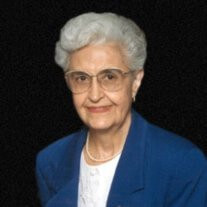
Photo from https://www.morrisfamilyfuneralhome.
com/obituaries/Betsy-Ewing/
Leader of Deaconesses and Women's Mission Work
Ewing came out of the Methodist Episcopal Church, South, although it became part of The Methodist Church when she was a teenager. As she was growing up, she planned to go to Scarritt College. She not only completed her education there but stayed on for fifteen years to work with alumni well.
Even though she went to a high school where students were segregated by gender and worked most of her life with women’s organizations, Ewing and her work are part of the church’s struggles with gender and gender roles.
When the Board of Missions went through its major restructure in 1964, it “radically changed the internal workings of the board and relationships.” Before men had “done their thing” at their headquarters in Philadelphia, women had “done theirs” in New York. She accepted the invitation to head up the deaconess program. The deaconesses had always been women, but as the board integrated various programs, it also opened this field of service for men, calling them “home missionaries.”
She also saw the differences as two systems of missions were brought together. The men had always been part of helping to raise the money through developing lists of friends and donors. Women had raised money through the local church groups and the structures that were in place at every level of the church. She saw the positive way the structuring helped to unify missions. Once of her concerns was communication. When she was growing up, she always her people complain, “Oh, those people in Nashville!” She wanted to be a liaison, to continue to communicate with people, even those who seemed to feel that the board was always dictating all the decisions.
Always a leader, she attended her first international meeting in West berlin in 1963. She wanted to host a meeting in the U.S. and invited the organization to come. That meant, however, that she had to bring together a national organization to prepare for the 1966 meeting. Later she went on to be president of Diakonia, an ecumenical experience that she felt really helped and enriched her work on the board, where eventually she became an administrative executive in New York.
Ewing appreciated the variety of organizations she worked with during her ministry—Scarritt-Bennett, the Board of Missions, Diakonia—all doing the same thing in different ways. As she looked back over her work, she noted how rewarding it had been. She was committed to what she was doing, got a lot of support, and found people to be very gracious. The challenge of working with people was one that she took on and mastered.
Taken from Linda Gesling, Mirror and Beacon: The History of Mission of The Methodist Church, 1939-1968. (New York: General Board of Global Ministries, The United Methodist Church, 2005), p. 289.




